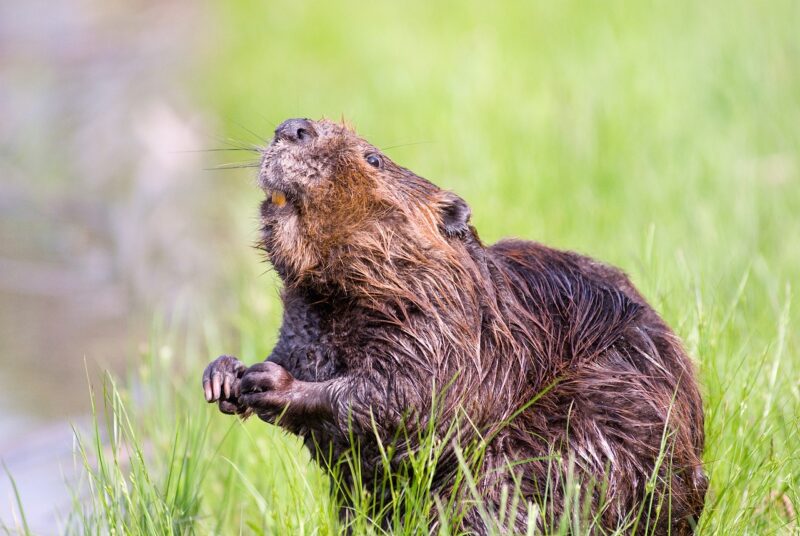Watch a video about the Beaver Restoration Program’s first translocation of beavers in California. Video via California Department of Fish and Wildlife (CDFW).
First ‘beaver translocation’ in 75 years
State officials in California are betting beavers (Castor canadensis) – the hard-working, once ubiquitous aquatic rodent – can help reinvigorate the towering peaks, deep river valleys and lush mountain meadows of the Sierra Nevada.
The California Department of Fish and Wildlife (CDFW) said in December 2023 that it had relocated a family of seven beavers within the wilds of the Central Sierra Nevada. It marks the launch of CDFW’s Beaver Restoration Program.
It’s the first time in 75 years that the CDFW has engaged in what it calls beaver translocation activities. Officials moved a breeding pair and their five offspring to Tásmam Koyóm, a valley in the mountains of Plumas County. The area is part of the ancestral lands of the Yamonim Maidu and a place where beavers once thrived.
2024 lunar calendars on sale now. Makes a great gift! Check it out here.
Beavers restore wetlands naturally
Charlton H. Bonham, CDFW Director, said his agency hopes a boosted beaver population will combat the state’s wildfire problem while creating habitat for other native species:
Beavers help retain water on the landscape, which increases groundwater recharge, improves summer baseflows, extends seasonal flows and increases fuel moisture during wildfire season, effectively creating green belts that can serve as wildfire buffers or breaks and provide refugia for wildlife.
The wetlands beavers create are absolutely critical to the survival of species that are teetering on the brink of extinction, says the nonprofit organization Beavers: Wetlands & Wildlife. But we reap the benefits too.
Beaver dams do more than restore wildlife habitat (their ponds are havens for nearly half the rare species), they also provide people with valuable natural services, such as water cleansing and stabile stream flows.

Relocation helps two environments
Years of preparation went into readying the translocated beavers’ new home. Conservation work – performed by a consortium of state and federal governmental agencies, tribal councils, ecological trusts and other groups – created an enticing environment. At least one local beaver was already calling Tásmam Koyóm home when the relocated animals arrived.
Beavers aren’t always beneficial, of course.
The relocated animals came from Sutter County to the north, where they were damaging habitat of other threatened and endangered species. And the CDFW knows beavers and humans can run afoul of one another. So they’ve prepared a guide on how to coexist peaceably. Financial assistance is even available if human-beaver relations get really out of hand.
Beavers help preserve heritage
California Natural Resource Agency Secretary Wade Crowfoot, like the beavers, is eager to see what the future holds:
Beaver relocation will help both to restore the environment and preserve traditional culture of our tribal partners who have stewarded these lands since time immemorial. I’m excited to watch how beavers will improve the health of landscapes in coming decades and support traditional lifeways for our diverse tribal communities.
The Yamonim Maidu people sees efforts like CDFW’s beaver conservation program as key to preserving their heritage:
The Maidu Summit Consortium envisions re-acquired ancestral lands as a vast and unique park system dedicated to the purposes of education, healing, protection, and ecosystem management based upon the Maidu cultural and philosophic perspectives, as expressed through traditional ecology.
The Tule River Indian Tribe has also been an important player in restoring the beaver population. CDFW’s next translocation will bring beavers to the Tule’s land in Tulare County in the Southern Sierra Nevada.
Beavers faced near-extinction
Beavers have had a rough time living with humans.
Today, as many as 15 million beavers call North America’s streams, creeks and rivers home. But the population was between 100 and 200 million before European settlers arrived. The Eurasian beaver has had it even tougher, with an even smaller remnant of the original population remaining. Beavers: Wetlands & Wildlife’s website describes the devastation the near-extinction continues to cause:
As beavers were eradicated in past centuries, their dams no longer filtered silt from streams, and kept water on the land longer. As beavers were wiped out, the majority of wetlands were drained, and waterways became disconnected from their floodplains. Rivers became more like canals or sewers, leading to today’s problems with water pollution, erosion, and escalating damage from regional floods and droughts.
April 7 is International Beaver Day!
That’s why the organization established International Beaver Day on April 7 of every year. It’s an opportunity to call attention to efforts to restore beavers to their former glory. They suggest getting involved directly:
Help people learn about these amazing animals on International Beaver Day, April 7th. International Beaver Day is a fine time to hike to a beaver pond, arrange a display of books in your library, show a beaver video, and/or otherwise spread the word about nature’s engineer.
The wetlands beavers create are home to a diversity of species on par with tropical rainforests. Busy beavers just doing what comes naturally restores wetlands far more quickly and efficiently than humans can. And they work cheap.
Today, manmade (mitigation) wetlands cost from $10,000 to $100,000 per acre to build, while each beaver family creates and maintains several acres of wetlands — for free.
Bottom line: Officials in California are relocating beavers (Castor canadensis) to help improve the state’s mountain environment and waterways.
Read more: Why super-size beavers went extinct
Read more: Parachuting beavers created a fire-resistant wetland











